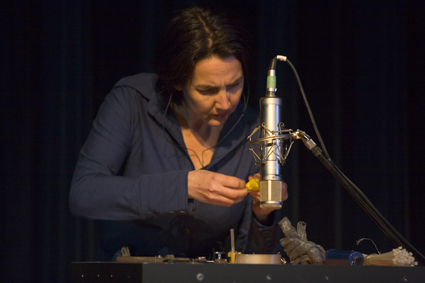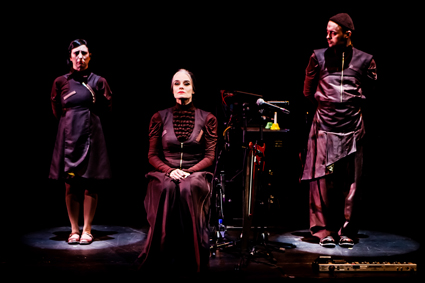deep fear and light obsession
fiona mcgregor: pin drop and rramp, performance space

Tamara Saulwick, Pindrop
photo Ponch Hawkes
Tamara Saulwick, Pindrop
PIN DROP CAME TO PERFORMANCE SPACE DRESSED IN ACCOLADES AND AWARDS, MOST NOTABLY MELBOURNE’S 2010 GREEN ROOM AWARD FOR OUTSTANDING PRODUCTION. IT IS MINIMALIST, IMMERSIVE THEATRE, THE STAGE QUITE BARE AND PERFORMER SAULWICK OFTEN STATIONARY AT A SMALL TABLE AS PETER KNIGHT’S EXTRAORDINARY SOUND DESIGN CARRIES THE PERFORMANCE.
Built around a series of audio interviews, Pin Drop is an exploration of fear. The real life stories it draws on range from accounts of violence through to false alarms. This sort of material has potential for suspension of belief or at the least banality because we have been here so often before—in this darkened alley or empty house—but Saulwick’s crafting is so refined that we remain on a knife edge for the entire show. Everyday objects on a small table—scissors, cable ties, sticky tape—conjure a domestic, suburban context. A place of neurosis perhaps, but equally one of terror, and most significantly a place where neurosis and terror are not mutually exclusive. Saulwick’s masterstroke is to use as few pointers as possible so the space we inhabit most of all is our own imagination. The objects and anecdotes are triggers and mnemonics into our deepest fears and worst stories. Saulwick’s movements are restrained, yet her presence is riveting. She is everywoman, at once participant and narrator. Her gestures and facial expressions are mostly preoccupied with the enigmatic interior.
Knight’s production is more visceral and engaged than mere soundtrack. Footsteps echo around the room. Saulwick speaks, yet you aren’t always sure where the live text ends and the pre-recorded begins. A sequence using the objects becomes high drama as ordinary noises treated with feedback become signifiers of doom. Silence is one of the most powerful sounds of all. Where you hear the pin drop.
Bluebottle’s set and lighting are just as intimate, as well as adept in the use of absence. When the performer is highlighted, you seek as much meaning in the blackness around her, as you do in her face. The lights are frequently so dim that you strain to see in the dark. What was that? My mind playing tricks on itself? Or is it just my imagination? Yes, it’s theatre, at its best a psychic state where fantasy and reality are one and the same.
In a climate that favours research over production, it is immensely gratifying to see such finely honed work. Time can wear things out, but Pin Drop’s two years of outings has surely worked in its favour. In some ways programming RRAMP, featuring Lisa O’Neill, Peter Nelson and Christine Johnston centrestage, was an unusual, if not risky, juxtaposition. Yet it paid off, even if Performance Space’s description of the Show On season as “contemporary performance that focuses on audience participation and the intersection of art, life and popular culture” lacks concision. Pin Drop and RRAMP (incidentally neither participatory) were like two houses in the same street, with very different tenants and design.

Lisa O’Neill, Christine Johnston, Peter Nelson, RRAMP
photo Sean Young
Lisa O’Neill, Christine Johnston, Peter Nelson, RRAMP
The darkness of Johnston’s persona is more about the loneliness of the outsider, the strangeness and wonder of life itself. Her suburban childhood, as with previous shows Decent Spinster and Fluff, is her font. In Rramp: The Collector, the Archivist and the Electrocrat she collaborates with long-time associates O’Neill and Nelson, each playing those characters in an “electronica dance metal rock set.” Animator Ahmarnya Price refreshes the team. Her projected illustrations of life in a chook run are dynamic, engaging and central to the work.
Johnston’s observations of her childhood chickens become epic: her first lessons in life, death, friendship and society. The collection of these stories is the show’s narrative thread, echoed visually by a series of jars used as repositories for all sorts of things, from memories to bones. A standout for me was the song—also wittily illustrated by Price—about receipts in files in boxes in the bedroom. It’s Johnston at her crazy, astute best, magnifying the everyday. She is a fine lyricist, as well as singer, with a unique vision.
Selena Cochrane’s elegant, quirky costumes meet the standard, which has a grandeur even while being utterly personal and idiosyncratic. There is the usual deadpan delivery, and Johnston’s Collector is Spinster enough for me to wonder why the line between the two has not been alluded to more. O’Neill is less of a stooge and Nelson’s musical skills more evident. Johnston’s extraordinary vocal abilities with birdcalls and singing the visual weren’t fully called upon in this production. Perhaps they will be as the work continues to be performed. Rramp could mature into one of Christine Johnston’s best performances yet.
Lisa O’Neill, Christine Johnston and Peter Nelson have recently titled their collaborative team RRAMP House.
Performance Space, Mobile States & Performing Lines: Pin Drop, creator, performer Tamara Saulwick, design & production Bluebottle (Ben Cobham & Frog Peck), movement Michelle Heaven, composition, sound design & operation Peter Knight, costume design Harriet Oxley; Lisa O’Neill & collaborators, RRAMP—the Collector, the Archivist & the Electrocrat, Christine Johnston, Lisa O’Neill and Peter Nelson, animations Ahmarnya Price, Performance Space, Carriageworks, Sydney, Aug 1-4
RealTime issue #111 Oct-Nov 2012 pg. 40






